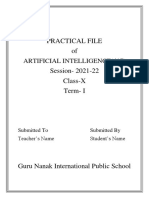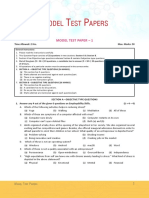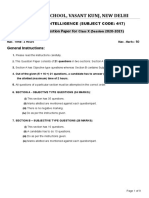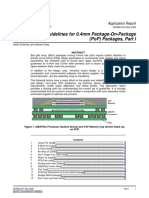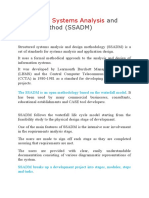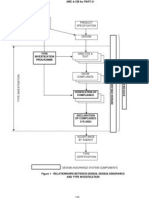Class 10 AI NOTES CHAPTER 1
Uploaded by
Vinayak ChaturvediClass 10 AI NOTES CHAPTER 1
Uploaded by
Vinayak ChaturvediCLASS 10
Question-Answers of Chapter-1 Artificial Intelligence
1.What is Artificial Intelligence?
Ans: Artificial intelligence can be defined as the ability of computer systems, i.e.
hardware and software, to do tasks that normally require human beings to use
intelligence.
2. Name the subfield of Artificial Intelligence.
Ans:
Machine Learning
Neural Networks
Data Science
Robotics
3. What do you understand by Machine Learning?
Ans:
Machine-learning refers to the capability of the artificially created system to learn
from experience, I.e. by processing data. For example, the process by which a
natural language translation program improves itself where used more and more.
This is one of the subfields of Artificial Intelligence.
4.What do you understand by Neural Networks?
Ans:
A neural network is a series of algorithms that endeavors to recognize underlying
relationships in a set of data through a process that mimics the way the human
brain operates.
5.What do you understand by Data Science ?
Ans:
Data science is the study of data. It involves developing methods of recording,
storing, and analyzing data to effectively extract useful information. The goal
of data science is to gain insights and knowledge from any type of data — both
structured and unstructured.
6.What do you understand by Robotics ?
Ans:
Robots are computing machines that have both hardware and software components
and robotics is the field which deals with construction and programming of robots.
7. Name the three domains of artificial intelligence .
Ans:
Data , Computer Vision (CV) ,Natural Language Processing (NLU)
8. What do you understand by computer vision? Write with an example.
Ans:
Computer vision is a field of artificial intelligence that trains computers to
interpret and understand the visual world. Using digital images from cameras and
videos and deep learning models, machines can accurately identify and classify
objects — and then react to what they see.For example Applications like Google
Photos use Computer vision technique to categories the photos .
9.What do you understand by Natural language processing? Write with an
example.
Ans:
It is a branch of artificial intelligence that deals with the interaction between
computers and humans using the natural language. The ultimate objective of NLP
is to read, decipher, understand, and make sense of the human languages in a
manner that is valuable .
10.What is the role of data in AI?
Ans:
Data is at the core of the all Al systems . Every Artificial Intelligence System
irrespective of its function , nature, or capability is heavily dependent on data for
its functioning. Here data as a domain is talking about textual data required for AI
solutions.
11.Write the types of data
Ans:
Audio data ,Video data , Textual data ,Big data
12. Write briefly about sustainable development goals in terms of its origin.
Ans:
Sustainable Development Goals (SDGs) are the set of 17 goals that were adopted
at the United Nations Conference on Sustainable Development in Rio dejaneiro in
2012. The SDGs were adopted to meet the urgent challenges of the world covering
the following three dimensions:
1. Environmental
2. Social
3. Economical
13.What do you understand by the term sustainable development?
Ans:
Sustainable development Is the development that meets the needs of the present
without compromising the ability of future generations to meet their own needs’.
This definition can be broken into the following components:
1. The development that satisfies the present needs.
2. The development that will allow future generations to meet their needs.
14.Write 17 SDG.
Ans:
1. No poverty
2. Zero hunger
3. Good health and well being
4. Quality education
5. Gender equality
6. Clean water and sanitation
7. Affordable and clean energy
8. Decent work and economic growth
9. Industrial innovation and infrastructure
10.Reduced inequalities
11.Sustainable cities and communities
12.Responsible consumption and production
13.Climate action
14.Life below water
15.Life on land
16.Peace justice and strong innovation
17.Partnership for the goals
15.What can be the possible solution to handles goal number 16 (Ensure
availability and sustainable management of water and sanitation for all).
Ans:
Sustainable Development Goal 16 deals with the sustainable management of water
and sanitation. Al based ‘Smart Water Management’ solutions using smart pipes,
soil sensors, smart irrigation management, smart rainwater harvesting, smart water
meters, smart water flow control software, etc. are helping in attainment of this
goal.
16.What can be the possible solution to handles goal number 7 (Affordable
and clean energy)
Ans:
In this area, the experts are expecting Al-based smart energy solutions using smart
grids, smart appliances, smart energy storage, smart meters, sensors, smart demand
regulations, etc. to cause minimum energy saving of 1.3 billion MWh by the year
2030.
17.What can be the possible solution to handles goal number 12 (Reasonable
Consumption and Production)
The artificial intelligence based smart systems like smart farm management, smart
irrigation, precision agriculture, etc., are helping in achieving the Sustainable
Development Goal 12 by boosting farm productivity and reducing wastage.
18. What do you understand by AI-Ethics?
Ans:- The term ‘Al Ethics’ is used to deal with all the ethical concerns and issues
related to Al systems. Al ethics are normally divided into two categories:
concerns related to data (Bias and inclusions) used in the Al systems and
concerns related to implications of the Al technology itself.
We can define ‘ethics’ as a system of moral principles that govern individual’s
behaviour or actions. Ethics are concerned with what is suitable for individuals and
societies. Similarly, ethical concerns are the issues, situations, or concerns that
cause individuals, societies and organizations to evaluate different choices in terms
of what is right (ethical) and what is wrong (unethical).
19. Explain the concerns related with data in terms of AI-Ethics.
Ans:
Data is the lifeblood of Al systems. These systems cannot exist without the data.
But the collection, storing and usage of this data raises serious privacy concerns.
Take a simple example of Google which uses data of its users for increasing its
revenue. One of the products offered by Google is Android operating system. This
operating system comes with number of google apps preinstalled. So if you are
using these apps and you have provided permissions in some instances that Google
has the following information related to you:
1. Contact: Google knows the name and phone number of all of your friends,
relatives, business partners, colleagues etc. from your phone book.
2. Location: Google knows the location of your house, your friend’s house, houses
of your relatives, your school, office, favourite mall, favourite cinema house.It also
knows the time you spend in these locations, the routes you take to reach them.
With a little effort it can predict if you own a vehicle, use public transportation
system, carpool or your parent’s chauffeurs you.
3. E-mail: Google knows every single mail written and received by you. It also
knows about the mails which you never read and the mails which you wrote but
never sent. It knows about the job offers received by you, and it knows about the
job you were rejected.
4. Photos: All the images of you and your friends along with their names linked
with a contact list, Google knows their phone numbers, email-IDs, addresses, etc.
Linked with calendar, it also knows about important events like their birthdays,
marriage anniversaries, birth of their children, etc.
The information is collected in lieu of providing us with helpful services, but the
potential risk here is very high. Google has all the details like your search history,
your internet browsing habits, your phone using habits, etc. Try to imagine the
extent and the depth of the data which the companies like Microsoft, Facebook,
Twitter, Amazon have about you , and you will have a clear understanding of the
ethical concerns related to the data collection.
20. What do you understand by Bias and problem of inclusion in terms of AI-
Ethics?
Ans:
The problem here is that the Al system learns from the real-world data fed into it.
This means that Al systems can reinforce the biases found in Al systems. For
example, a computer system trained on the data for last 200 years might find that
more females were involved in specific jobs or that more percentage of successful
businesses were established by men and conclude that specific genders are better
equipped for handling certain jobs (gender bias).
An algorithm used by the criminal justice system to predict which offenders were
most likely to become repeat offenders discriminated against people of color. A
major corporation’s AI-powered CEO search showed bias against women. Facial
recognition software proved woefully inaccurate unless the subject in question was
white and male.
THE PROBLEM OF INCLUSION
Al systems trained on biased real-world data create the problem of inclusion, i.e.
the problem that some people are left out of Al decision-making system. Consider
the example of Al system used by Amazon for recruitment. This created a situation
in which many eligible females were left out of consideration. This is known as the
problem of inclusion.
21. List the Ethical concern related to adoption of AI system
Ans:
1. Data Privacy
2. Bias and problem of inclusion
3. Job loss
4. Increasing inequalities
5. Negative adoption
6. Black box problem
22. What do you understand by Black box problem?
Ans: Al systems — especially the ones based on neural networks — cannot explain
the reasoning which they used for arriving at a particular decision or solution. Most
of the time, even their creators cannot explain the process of this decision making.
This Is known as the Black Box problem. What happens insider the Black Box
remains in the Black Box forever .
Example:
Back in 2015, software engineer Jacky Alciné pointed out that the image
recognition algorithms in Google Photos were classifying his black friends as
“gorillas.” Three years later in 2018, Google ‘fixed’ its racist algorithm by
removing gorillas completely from its image- labelling tech. They did not solve the
problem was because they were unable to understand why the problem was
occurring.
23. How the growth of AI will increase the inequalities?
Ans:
The current economic system provides economic rewards based on contributions to
the economy. This is true for all the economies, i.e. capitalist, socialist,
communist., mixed, etc. The direct consequence of Al adoption will be reduction
In number of people required for doing certain specific jobs. This, in turn, will
result in transfer of economic benefits from the persons doing these jobs to the
companies managing the Al system. This will Increase the income gaps and lead to
concentration of economic benefit in the hands of the few individuals.
24. How can AI encourage negative activity in society?
Ans:-
History shows that human beings are capable of finding negative or evil uses of
every technology ever discovered. This is also true for Al systems. In the hands of
the terrorists it can become a potentially potent tool of spreading terror. In the
hands of cybercriminals this can be a dream come true for their hacking and
damaging needs, and in the hand of rival countries these technologies can spell
doom for us.
25. Explain two cases of AI-Bias.
Ans:
Amazon Recruitment tool :
Amazon HR reportedly used an AI-enabled recruiting software between 2014 and
2017 to help review resumes and make recommendations. The software was
however found to be more favorable to male applicants because its model was
trained on resumes submitted to Amazon over the past decade, when many more
male candidates were hired.
Northpoint’s tool COMPAS for Judiciary services:
In 2016 The scientist developed a system to predict the chances of repeated offence
by a criminal. The idea was to help the judges for better judgement . The system
picked up racial bias that had existed in America for hundred of years and became
biased toward the black community.
26.Write the example of applications related with data science.
Ans:
Price Comparison Websites , Rock paper scissors , Tic-Tac-Toe
27.Write the example of applications related with computer vision.
Ans: Self-Driving cars/ Automatic Cars , Face Lock in Smartphones ,Emoji
scavenger hunt
28. Write the example of applications related with Natural Language processing.
Ans: Google home, alexa ,Email-Filtering
You might also like
- Chapter 1 Revisiting Ai Project Cycle and Ethical Farmework100% (2)Chapter 1 Revisiting Ai Project Cycle and Ethical Farmework6 pages
- Artificial Intelligence Class IX Code 417 Part B Unit 175% (32)Artificial Intelligence Class IX Code 417 Part B Unit 130 pages
- Implementing Aruba ClearPass Lab Guide With Covers Rev 20.11No ratings yetImplementing Aruba ClearPass Lab Guide With Covers Rev 20.11433 pages
- Answer Key Sample Paper 1 AI Class 10 TutorialaicsipNo ratings yetAnswer Key Sample Paper 1 AI Class 10 Tutorialaicsip11 pages
- Practical File Artificial Intelligence Class 10 For 2022-2390% (10)Practical File Artificial Intelligence Class 10 For 2022-2324 pages
- AnswerKey TRM-417 IX With Emp Skills167585035167% (9)AnswerKey TRM-417 IX With Emp Skills167585035156 pages
- MCQ Artificial Intelligence Class 10 Data Science0% (1)MCQ Artificial Intelligence Class 10 Data Science16 pages
- Natural Language Processing Notes Class 10 AI100% (1)Natural Language Processing Notes Class 10 AI20 pages
- Practical File Of: Artificial IntelligenceNo ratings yetPractical File Of: Artificial Intelligence4 pages
- Class X - Artificial Intelligence - Evaluation - Question Bank83% (6)Class X - Artificial Intelligence - Evaluation - Question Bank8 pages
- MCQ Artificial Intelligence Class 10 Computer Vision100% (3)MCQ Artificial Intelligence Class 10 Computer Vision41 pages
- NLP Worksheet: Text Processing, Bag of Words and TF-IDF100% (2)NLP Worksheet: Text Processing, Bag of Words and TF-IDF10 pages
- Class Ix - Artificial Intelligence - Unit-2 Ai Project Cycle Assignment-10% (2)Class Ix - Artificial Intelligence - Unit-2 Ai Project Cycle Assignment-14 pages
- AI IN MATHS & GENERATIVE AI NOTES_ CLASS IX67% (3)AI IN MATHS & GENERATIVE AI NOTES_ CLASS IX3 pages
- Csiplearninghub Com Unit 3 Basic Ict Skills Class 10 Notes It 402100% (3)Csiplearninghub Com Unit 3 Basic Ict Skills Class 10 Notes It 40222 pages
- 4W Canvas On Transportation Problem in Remote Areas100% (1)4W Canvas On Transportation Problem in Remote Areas1 page
- IX - ARTIFICIAL INTELLIGENCE - Sample Paper60% (5)IX - ARTIFICIAL INTELLIGENCE - Sample Paper3 pages
- Dav Public School, Vasant Kunj, New Delhi: Artificial Intelligence (Subject Code: 417)No ratings yetDav Public School, Vasant Kunj, New Delhi: Artificial Intelligence (Subject Code: 417)8 pages
- UNIT-1 Introduction To AI 1.1 Excite: AnswerNo ratings yetUNIT-1 Introduction To AI 1.1 Excite: Answer10 pages
- Qfix Payment Receipt Nov Oh Mess Bill 24 Basic (1)No ratings yetQfix Payment Receipt Nov Oh Mess Bill 24 Basic (1)1 page
- A Comprehensive History of Modern India @UPSC_THOUGHTSNo ratings yetA Comprehensive History of Modern India @UPSC_THOUGHTS635 pages
- JD - Private Banking Relationship ManagerNo ratings yetJD - Private Banking Relationship Manager1 page
- Job Description Form Influencer Relations Manager MBA IIM Calcutta - Finals 2025No ratings yetJob Description Form Influencer Relations Manager MBA IIM Calcutta - Finals 20253 pages
- OB-243_Managing Teams in Organizations-2024-25No ratings yetOB-243_Managing Teams in Organizations-2024-254 pages
- Full Rehearsal & Programme Schedule of 60th Annual Convocation 2025No ratings yetFull Rehearsal & Programme Schedule of 60th Annual Convocation 20251 page
- NCERT_Course_Class_2_-_9C3__1744456827751 (1)No ratings yetNCERT_Course_Class_2_-_9C3__1744456827751 (1)2 pages
- Printed by SYSUSER: Dial Toll Free 1912 For Bill & Supply ComplaintsNo ratings yetPrinted by SYSUSER: Dial Toll Free 1912 For Bill & Supply Complaints1 page
- Assignment-3: MN 332: Writeup Listing Different Geotechnical InstrumentNo ratings yetAssignment-3: MN 332: Writeup Listing Different Geotechnical Instrument5 pages
- Particularly Vulnerable Tribal Groups: Why in NewsNo ratings yetParticularly Vulnerable Tribal Groups: Why in News1 page
- India - IRAN: By: Harveer Singh +91-880-2009-420No ratings yetIndia - IRAN: By: Harveer Singh +91-880-2009-4204 pages
- PCB Design Guide Lines For 0.4mm Package-On-PackageNo ratings yetPCB Design Guide Lines For 0.4mm Package-On-Package26 pages
- Effects of Globalization On Pakistan's Education-Fahad50% (2)Effects of Globalization On Pakistan's Education-Fahad6 pages
- Structured Systems Analysis and Design MethodNo ratings yetStructured Systems Analysis and Design Method6 pages
- Myp Year 1 Design 6: 2014 - 2015 Scope and Sequence: August-DecemberNo ratings yetMyp Year 1 Design 6: 2014 - 2015 Scope and Sequence: August-December2 pages
- Blinding Deblinding Best Practices Lessons From of Adnoc Gas Processing100% (1)Blinding Deblinding Best Practices Lessons From of Adnoc Gas Processing26 pages
- Project Plant Pals Operations & Training PlanNo ratings yetProject Plant Pals Operations & Training Plan3 pages
- Products AND Services: Efficient Plastics Processing Made by ARBURG"No ratings yetProducts AND Services: Efficient Plastics Processing Made by ARBURG"32 pages
- 1950 Labbe - Modern Baghouse Practice For The Recovery of Metallurgical FumesNo ratings yet1950 Labbe - Modern Baghouse Practice For The Recovery of Metallurgical Fumes5 pages
- Read First: Follow Directions To Avoid Damaging Your New V3 Predator Board During The Installation ProcessNo ratings yetRead First: Follow Directions To Avoid Damaging Your New V3 Predator Board During The Installation Process4 pages
- Science and Technology Questions and Solutions PDF 2022No ratings yetScience and Technology Questions and Solutions PDF 20226 pages



































